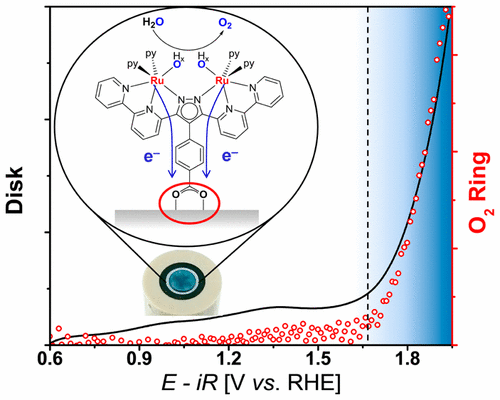Efficient catalysts for water oxidation are key to all scenarios for artificial solar water splitting, and in case of molecular catalysts their immobilization on conductive solid supports is considered essential for the construction of a photoelectrochemical cell. In this work, derivatives of the rugged 3,5-bis(bipyridyl)pyrazolate (bbp) based diruthenium water oxidation precatalyst [(μ-bbp){Ru(py)2}2(μ-X)]2+ (X = OAc, CO3H) have been synthesized that are equipped with a carboxylate anchor at the ligand backbone. The para-C6H4COOR (R = Et, H) substituent at the pyrazolate-C4 is shown to not have any significant effect on the electronic properties of the bbp-based diruthenium core, or on the catalytic performance when using CeIV as a chemical oxidant. The bbp-based complex with labile exogenous bicarbonate bridge (4) has been successfully anchored on mesoporous ITO (mesoITO), and the hybrid ITO|mesoITO|4 shows electrochemical signatures similar to those of the homogeneous system. Its electrocatalytic water oxidation performance at pH 1 has been investigated by rotating ring disk electrode (RRDE) measurements, and high faradaic efficiency is evidenced by the agreement of Tafel slopes for the disk and ring currents. X-ray photoelectron spectroscopy (XPS) data before and after electrochemical measurements were compared to evaluate the chemical stability of the immobilized complex 4 during catalysis, showing that the surface-bound complex species stays intact without any decomposition to RuO2. However, gradual leaching of the complex leads to decreasing catalyst concentration and decreasing activity during electrocatalysis, reflecting weak attachment of the carboxylate anchor to the oxide substrate and emphasizing the need for improved anchoring strategies.
